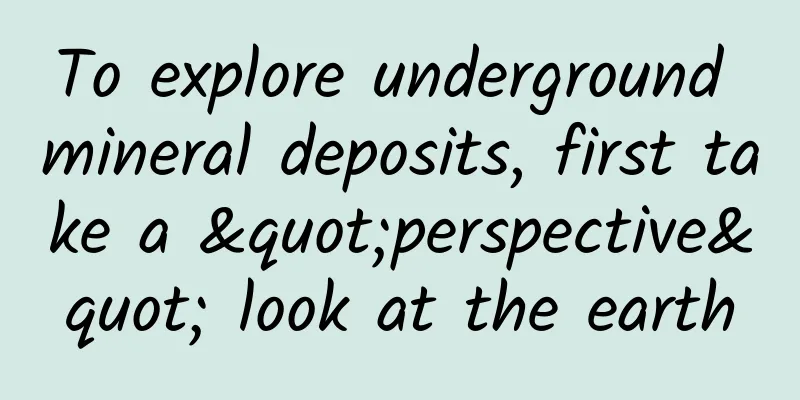To explore underground mineral deposits, first take a "perspective" look at the earth

|
On August 27, the drilling depth of my country's first 10,000-meter exploratory well, Shendi Tako 1, reached more than half, reaching 5,945 meters, and is advancing to ultra-deep formations above 6,000 meters. Shendi Tako 1 was drilled in the Taklimakan Desert in Xinjiang on May 30 this year, with a designed well depth of 11,100 meters. Since the first conquest of Mount Everest in 1953, humans have challenged the world's limits time and again. It is difficult to go up to the sky, and it is even more difficult to go underground. It is even more difficult to find oil treasures in the strata thousands of meters underground. Oil workers are not to be outdone. In 2020, they drilled a high-yield oil and gas flow in the Luntan Well 1 at a vertical depth of 8,882 meters underground, making it the deepest well on land in Asia. The Fuman Oilfield, China's largest ultra-deep oilfield located in the heart of the Taklimakan Desert, has made continuous progress in exploration and development since its discovery in 2013, with cumulative oil and gas production exceeding 10 million tons. How was the oil found? Geophysical exploration is the golden key to unlocking the underground oil and gas treasures. It is similar to doing a CT scan of the earth, discovering the oil and gas resources stored underground through purposeful "scanning and testing", allowing geologists to see deeper and have a wider field of vision. If you want to know what is underground and where the mineral deposits are, you need to conduct seismic exploration. Seismic exploration is divided into three steps: data collection, processing, and interpretation. my country has conducted independent research and development in each link and has formed a series of supporting technologies and software equipment. The first link is seismic data collection. Through my country's independently developed G3HD wired seismic instrument, eSeis wireless node seismometer, EV-56 high-precision controllable source and other advanced equipment and technologies, researchers collect and observe data on the ground. As an artificial source, the EV-56 high-precision controllable source first stimulates seismic waves and begins to scan the earth. The G3HD wired seismic instrument and eSeis wireless node seismometer harvest reflected wave field data, which can infer the structural morphology of underground rock formations or the original seismic data of lithological characteristics, but this cannot reveal the mystery of the underground. The second step is to process the seismic data obtained by "seeing through" the earth and take a CT image of the earth. Doctors can get the image quickly after doing a CT scan on a patient, but CT scans of the earth are much more complicated than those of the human body, and imaging of underground strata often requires the help of high-performance computers. Using the self-developed super-large GeoEast seismic data processing and interpretation integrated system, technicians can obtain a three-dimensional underground stratum imaging profile data body after dozens of steps. The third step is to determine the location of oil and gas. Oil and gas are buried deep underground. Where did they come from? Where are they hidden now? How can we find them? By establishing a connection between seismic profiles and underground strata, researchers draw stratigraphic maps, find geological information related to oil and gas, and locate the location of oil and gas reservoirs. In this way, the stratigraphic structures from the surface to tens of thousands of meters deep underground have been excavated. Geophysical exploration comes first when searching for oil and gas. This is how oil and gas reservoirs are discovered. From climbing up the "razor-blade mountains" to exploring the "underground Mount Everest", the pace of technological innovation by oil geophysical explorers has never stopped. Every exploration in the exploration restricted area is a report card of scientific and technological self-reliance and self-improvement, and a mission and responsibility of the country. (The author is an assistant political worker at China National Petroleum Corporation Oriental Geophysical Exploration Co., Ltd. and the second prize winner of the 9th National Science Popularization Explanation Competition) |
<<: Protein factories: Using the power of evolution to defeat the enemy
>>: Chinese scientists discover new cell type, plants can move now!
Recommend
I'm going to share 48 tricks to attract fans. If you don't have fans anymore, you can only blame yourself.
I'm going to share 48 tricks to attract traff...
How to create a hit title with over 100,000 views? Just master these 5 points!
Let’s take you to re-examine the meaning of title...
Cognition and scale—how do operations intervene in products?
Products and operations may indeed conflict over ...
Attention! Don’t post these things to your friends circle
Chinese New Year Also in the circle of friends Th...
Better display? The difference between HDR and UHD technology revealed
Friends who are interested in display technology k...
Huawei's third-generation intelligent torque control system is first used in Avita
Judging from the current results, Huawei has buil...
R7s hands-on experience: rejecting the common face and being more popular
On October 20, 2015, OPPO held its autumn new pro...
The dilemma of Three Squirrels’ e-commerce marketing!
As the annual "Double Eleven" approache...
[Must-Read for Internet People] After a few years in the industry, where should your future be?
Anyone who has been in this industry for three to...
8,000-word explanation of how online education institutions can create an excellent training camp product
If you are working in the education industry, you...
Tik Tok live broadcast from 0 to 1 script template
Five basic steps for sales 1. Raise questions: Ra...
The natural "carpet" of the Qinghai-Tibet Plateau has been renewed! Scientists have discovered 11 new species of lichens
The Qinghai-Tibet Plateau has an average altitude...
Is tomato a vegetable or a fruit? Let’s start with a strange case…
In 1893, the U.S. Supreme Court heard a peculiar ...
Patron? Protector? Friend? The relationship between the founding father and the sculptor
In the great sculpture era with many stars shinin...
Teach you how to analyze the Android system startup process step by step
[[424940]] In the previous article, we talked abo...









